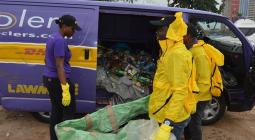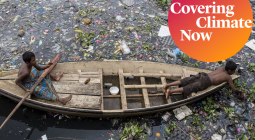Africa's exploding plastic nightmare.

As Africa Drowns in Garbage, the Plastics Business Keeps Booming
ROSEMARY NYAMBURA SPENDS her weekends collecting plastic with her aunt Miriam in the Dandora dump in Nairobi. Because the bottles they sell to other plastics traders are mixed in with discarded syringes, broken glass, feces, fragments of cellphone cases, remote controls, shoe soles, trinkets, toys, pouches, clamshells, bags, and countless unrecognizable shreds of thin plastic film, the work is time-consuming and dangerous. But Rosemary, who is 11, is hopeful that her effort will pay off. Several of her six cousins, whom she has lived with since her mother died, have already dropped out of high school because her aunt couldn’t afford their school fees. If Rosemary makes it through elementary and secondary school, and then college and medical school after that, she vows to return to Dandora. “I see how people get sick a lot here,” Rosemary said on a recent Saturday, as she stood atop a mound of rancid trash. “If I become a doctor, I would even help them for free.”
It will take a long time for Rosemary to earn enough to pay for school with her earnings from discarded plastic. Everything that’s worth anything in Dandora, which stretches for more than 30 acres in the eastern part of the Kenyan capital, is contested. Groups of local businessmen control who trades and collects waste in the dump and even charge fees to enter certain areas. Birds, cows, and goats have staked out their own grazing spots on the mounds. And waste-pickers sometimes fight over the best finds. Discarded airplane food can spark some of the fiercest fights. Whoever wins completely devours every bit of the old, dry rolls, congealed meat, and overcooked pasta, even the contents of the tiny tub of butter, before tossing the plastic packaging onto the vast piles.
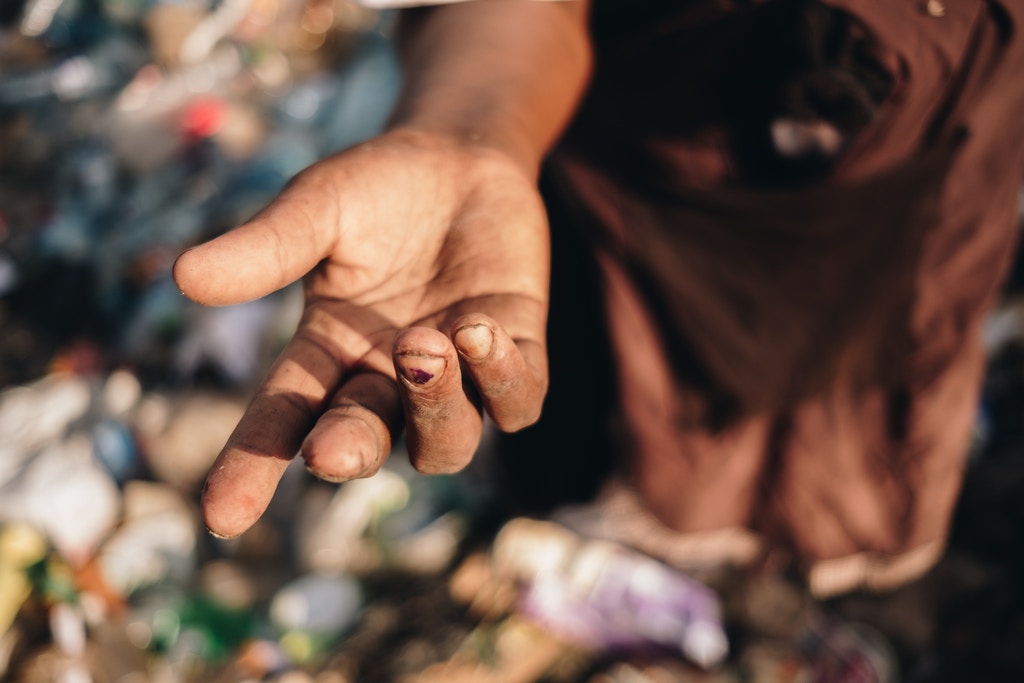
Traders who sit along the edges of the dump buy soda bottles made from PET, or polyethylene terephthalate, which Miriam gathers seven days a week, for less than 5 cents a kilogram — more than the cardboard boxes she also picks off the heaps, but far less than what they’ll pay for the same weight of metal cans. It can take many hours, even days, to collect a kilo of plastic bottles. And the bags that can fit them all, called diblas, are too big and unwieldy for children to carry.
A local youth organization, Dandora HipHop City, came up with a way for kids who live near the dump and don’t have the strength or time to gather a whole kilo of plastic to still get something for individual bottles and other pieces of plastic they gather. At the group’s “bank,” a storefront one block from the dump, kids can earn points for even a single plastic bottle, which they can then redeem for cooking oil, flour, vegetables, and other essentials. The organization, which was founded by a hip-hop artist who grew up nearby, also runs a youth program in a building on the edge of the dump. Festooned with hand-painted art and furnished with scavenged scraps that serve as chairs and sofas, the building provides a place for the kids to compose music on old computers, write, play games, and just pass the time.
But the small amount the group gets for collected plastic on the informal market doesn’t cover the food it gives out through its bank, so Dandora HipHop City has been using donations from its employees and their friends to pay for its programs. The group attempted to get a grant from Coca-Cola, which seemed like a perfect corporate sponsor. Coke, which is valued at more than $200 billion, sees Africa as “one of the core growth engines for the company going forward,” as CEO James Quincey recently put it. And the children of Dandora, who suffer from hunger, neglect, and a variety of health problems related to the dump, clean up many of the company’s bottles — sometimes gathering them when they should be in school.
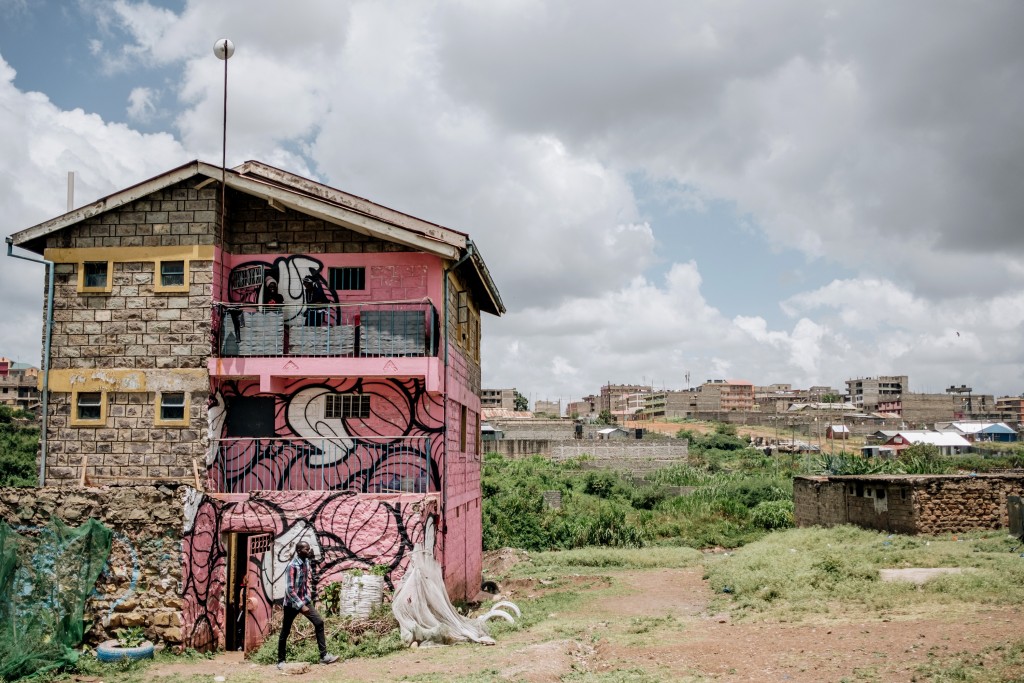

In September 2018, Coke brought a delegation out to the dump to meet with the youth organization. Charles Lukania, programs manager of Dandora HipHop City, says that afterward, he sent a proposal and budget to some of the Coca-Cola marketing staff who had visited outlining how the company could support its bank project. But the visit — and the proposal — didn’t lead to any funding. Instead, “they offered to give us a fridge full of Coke the kids could buy,” said Lukania, who noted that most of the children at the dump can’t afford soda. “Whatever little money they have goes to buy food.”
Later that month, the company partnered with the youth organization on several cleanup days, but those events didn’t involve any direct financial support either. Instead, Coke’s contribution toward those collaborations was Coke, the soft drink, which the volunteers were given only after they had spent hours cleaning up garbage in the hot sun. “And all the refreshments were in plastic bottles,” said Lukania.
In an emailed response to questions from The Intercept, Camilla Osborne, head of Coca-Cola’s communications for southern and eastern Africa, acknowledged that “our bottling partner Coca-Cola Beverages Africa in Kenya provided hydration and recycling bins” at one of Dandora HipHop City’s events. But, according to Osborne, “the company and its bottling partners in Kenya are not aware of a specific request for a grant from the group, and has not had any direct engagement” with Dandora HipHop City.
Osborne’s email also noted that “No one organisation alone can solve the world’s plastic problems.”
To be fair, Coke is just one of many companies that have foisted the costs of cleaning up their products and packaging onto the public. While Coke was the biggest source of plastic waste in both Africa and the world, according to a 2019 global brand audit of plastic waste, all sorts of companies that make plastic and use it for packaging have left the public to deal with the expense of addressing and preventing the harm caused by their products.
In the U.S., this externalizing of corporate costs has left municipalities shouldering the collection, carting, and processing of their plastic garbage. For decades, this burden was masked by the export of some 70 percent of the waste to China. But since China closed its doors to most U.S. plastic in 2018, some cities have found that they don’t have the money to recycle and have abandoned the practice, causing widespread inconvenience and a growing awareness of the persistence of plastic.
In poor countries, which are now bearing a disproportionate burden of the global plastics crisis, the calculus is different. While environmental outrage has constrained markets in many wealthier nations and, after the coronavirus pandemic, will likely cut further into the acceptability of plastics there, the use of plastic and products packaged in it is still growing quickly throughout Africa and elsewhere in the developing world. Meanwhile, since China’s policy change on scrap plastic, the U.S., Australia, and many European nations have been exporting their waste to other countries that are far less able to deal with it. Without the infrastructure to process the waste or the funds to fob it off on others, the plastic has swamped these nations, filling waterways, clogging roads and fields, and becoming intricately mixed into animal feed. Plastics don’t biodegrade, so the tiny shreds will remain in water, soil, and air for centuries.
While the plastics crisis has largely played out on the administrative level in the U.S., burdening local governments with the growing costs and logistics of managing plastic garbage, in developing countries that have no government-funded waste collection or recycling systems, those burdens fall on individuals. In Kenya, where some 18 million people live on less than $1.90 per day, the responsibility offloaded by some of the most profitable companies in the world falls to some of the poorest individuals in the world, like Rosemary and her aunt. And Kenya is just one of dozens of developing countries where plastic is causing massive human rights and child labor problems, in addition to environmental devastation.

Dump, Dump, Burn
Even under the best of circumstances, plastic recycling doesn’t work very well. Unlike glass, which can be repurposed infinitely, plastic can be significantly worse for wear after being recycled just once. “Every stage of post-use treatment degrades the functional quality of the polymer,” Kenneth Geiser, emeritus professor at the University of Massachusetts at Lowell, explained of the molecules that make up various plastics. “Polymers generally lose strength, stability, and moldability as the linear molecular bonds are severed or broken during recycling processes,” said Geiser, who founded the Center for Environmentally Appropriate Materials. All plastic contains chemical additives, which affect its color, moldability, and other attributes. And those chemicals further complicate the recycling process. “So even if in the laboratory, a polymer can be remelted and reformed, it is not so easily accomplished in actual practice.”
Wealthy countries fail to recycle the vast majority of their plastics, a process that involves cleaning, sorting, and grinding it, then turning the ground plastic into bits called flake, and ultimately converting the flake into new products. In the U.S., the plastic recycling rate peaked at 9.5 percent in 2014. But in developing countries that lack infrastructure, the process is harder — and more difficult to pay for. Throughout the world, the value of recycled plastic is undercut by “virgin,” or newly produced plastic, which is cheap both because of the low cost of the subsidized fossil fuels used to make it and because its pricing doesn’t reflect the cost of cleaning it up.
In Nigeria, a kilo of empty metal cans fetches 10 to 15 times what scrap plastic does. In Zambia, “nobody will buy it,” said Michael Musenga, director of the Children’s Environmental Health Foundation. “People move it from one place to another and just burn it.”
In India, where there is little financial incentive to retrieve plastic, the waste piles up quickly. A 75-foot tall heap of mixed plastic and organic garbage known as Mount Pirana has risen near a school in the western city of Ahmedabad. Every day, 4,000 tons of new waste are added to the landfill, and children who live near it suffer from headaches, nerve pain, respiratory problems, and cancers, according to Mahesh Pandya, an environmental and human rights activist who has been working with them.

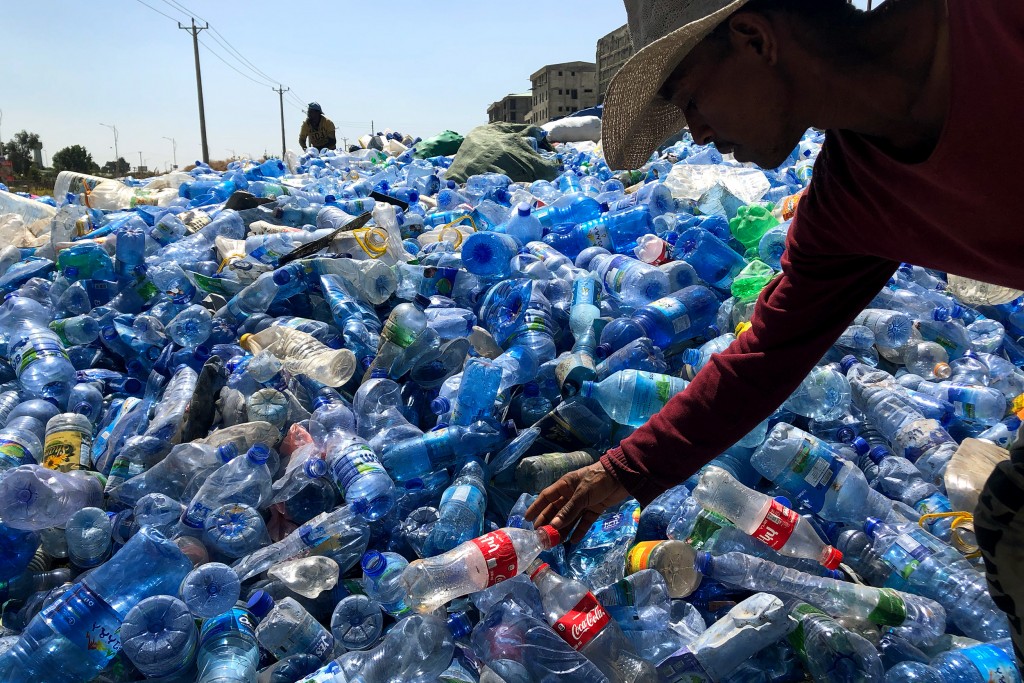
On a patch of land near Samit Road in Addis Ababa, Ethiopia, Hala Debeba and a group of his friends have been living on the thin profit margins of recycled plastic for the past 10 months. As cars rush by and goats snooze on the road’s median nearby, the traders buy plastic bottles from waste-pickers, mostly women, who carry them in giant bags balanced on their backs and heads. Debeba and his crew sort them into even larger bags and sell those bundles to other traders, who cart the bottles to recyclers in trucks. At each stage of the informal economy, the profit margin is just a few cents more per kilo. Working 10 to 12 hours a day, seven days a week, the young plastics traders, who have named their business gwadenyochi, the Amharic word for friends, earn enough to rent a shared room where they sleep between shifts.
But the value of plastic is dropping here too. Even the most valuable resin — a thick, clear plastic known as “Obama” — is losing value. On good days, the durable plastic, which is kept in a special red sack apart from the others, can fetch just over $1 per kilo. Like the former president, who is beloved here for bringing people of different races together, Obama, which is used to hold the bottles of six-packs together, is seen as unifying. But both in the U.S. and around the world, plastic is creating stark divisions over who should be held accountable for the massive pollution it is causing.
The Great Divide
Two bills recently proposed in the U.S. Congress stake out the distinctly different views on how to handle the plastic waste crisis. One, the Save Our Seas Act 2.0, would use tax dollars to improve our existing system of recycling and find uses for existing plastic waste. The legislation also funds research into the possibility of using recycled plastic to make cars and bridges. The bill, which was introduced in June by Republican Sen. Dan Sullivan and passed the Senate in January, is supported by the American Chemistry Council, the trade group that represents the manufacturers of the chemical components of plastic.
The other bill, the Break Free From Plastic Pollution Act, which was introduced in the Senate in February, approaches plastics from a different perspective. Believing that “we cannot recycle our way out of this crisis using the system we have in place,” the bill’s Democratic co-sponsors, Sen. Tom Udall and Rep. Alan Lowenthal, would instead shift the responsibility for plastic waste onto manufacturers by creating a nationwide container refund program, mandating a temporary pause on the construction of new plastic production plants, and eliminating certain “unnecessary single-use plastic products” starting in 2022. The bill includes measures meant to verify that U.S. plastic waste isn’t being sent to other countries.
Even before the coronavirus crisis, the Udall bill — which the New York Times described as a “long shot” in early February — faced an uphill battle in Washington. Since the pandemic began, the bill’s prospects have in many ways become slimmer as industry has seized on the global emergency as an opportunity to promote its products.

The Plastics Industry Association, a trade group representing companies involved on all levels of plastics production, has supplied its member companies with form letters requesting that their businesses that make single-use plastics and other plastic products be exempted from stay-at-home orders. “From drug packaging to packaging for medical devices, as well as many of the medical devices themselves, plastics are essential to ensuring the safety of the healthcare workforce, patients and consumers,” the form letter addressed to “[State or Local Official]” explains. “We ask that you designate [Company] as ‘essential’ during this critical time.”
In March, the plastics trade group wrote to Alex Azar, the secretary of Health and Human Services, asking him to “make a public statement on the health and safety benefits seen in single-use plastics.”
Meanwhile, Matt Seaholm, executive director of the American Recycled Plastic Bag Alliance, a division of the Plastics Industry Association that works to prevent and roll back bans on plastic, has been tweeting articles and editorials from the Wall Street Journal, Forbes, Fox News, and other news outlets arguing that reusable shopping bags — or “bug-breeding reusable grocery bags,” as the New York Post recently put it — are a health hazard during the pandemic. While the coronavirus can also live on plastic, the articles focus on grocery bags as a source of infection. Most cite studies from a researcher named Ryan Sinclair, who provided an affidavit the Plastics Industry Association sent to Azar attesting to the threats posed by reusable grocery bags.
Sinclair has published three studies on the subject. One, from 2011, was funded by the American Chemistry Council. The others, published in 2015 and 2018, were supported by an obscure California-based group called the Environmental Safety Alliance, whose secretary is a former gun lobbyist who believes that laws should be based on the Bible. The organization has advocated against the use of reusable shopping bags since at least 2012. Although the 2018 study concludes that any threat of infection posed by reusable grocery bags could be countered by hand-washing and public education about the need to launder reusable bags, during the pandemic the plastics industry has used it to argue that bag bans should be rescinded. The petrochemical industry, which makes the chemical components of plastic, is also exploiting the pandemic to ask for the rollback of environmental regulations — and, in many cases, the U.S. Environmental Protection Agency is complying.
Some industry pushback is also being seen in Europe, where a plastics trade association recently wrote to the European Commission asking it to lift all bans on single-use plastic items and delay the implementation of a continent-wide ban that is supposed to take effect in July 2021. Industry has made similar requests in Turkey, Germany, and Italy.
Nevertheless, recently passed bans on single-use plastics in Europe and Canada remain on track to take effect next year. And the plastics industry’s opportunism has done little to reverse the wave of anti-plastics legislation that has left at least 127 countries with some kind of law limiting single-use plastics. The policy that is expected to deliver the most substantial blow to worldwide plastics demand — China’s ban on certain single-use plastics — became law in January and is due to take effect in Chinese cities by the end of this year.
In Africa, which leads the world in plastics bans, more than three dozen laws now restrict the use of plastics. Senegal’s recently passed ban on all water sachets and plastic cups is due to take effect on April 20. In Kenya, a plastic bag ban remains in place and is widely seen as a success. Since the bill’s passage in 2017, the discarded bags that had previously blown about in the streets, clogged streams, and hung from trees have all but disappeared.
The Kenyan government also passed a ban on all single-use plastics, including bottles, in national parks and protected areas, which is due to go into effect in June. But protected areas only make up about 11 percent of the country and a broader ban on plastic bottles will be more difficult, according to James Wakibia, a Kenyan photographer and activist who pushed for the bag ban. Wakibia said he met with little opposition in the four years he campaigned to ban plastic bags, but expects a national bottle ban will elicit a different response from beverage companies.
“The industry would not accept it,” said Wakibia. “Drinks in plastic are a thriving business in Kenya, and almost all companies have stopped using glass for plastic. They would go to any extent to stop such ideas, going to court, paying critics, doing crazy marketing and greenwashing in the name of conservation.”
In fact, shortly after Kenya’s National Environmental Management Authority raised the prospect of a nationwide ban on plastic bottles in January 2018, Coca-Cola, Unilever, and the Kenya Association of Manufacturers announced the formation of PETCO, a company that described itself as an effort of the Kenyan plastics industry to “self-regulate” the recycling of PET plastics. The companies undertook a similar effort with the same name in 2010, though it stopped functioning the next year.
PETCO has a green logo with the infamous triangle of arrows to indicate sustainability and uses the tagline “#do1thing. Recycle.” But it’s not an environmental organization. PETCO has its offices at the Nairobi headquarters of Coca-Cola, one of more than a dozen member companies. And although its formation seems to have quieted talk of a nationwide plastic bottle ban for now, it has clearly not fixed the plastic waste problem. PET bottles that used to hold Coke and other beverages can still be seen littered throughout the country — and projects that intended to use recycled PET plastic report not having enough of the material. That may be because PETCO provided only $385,400 in subsidies for the plastic recycling market in 2019, not enough to make the collection and processing of the plastic waste worthwhile, even for some impoverished Kenyans.
Joyce Wanjiru, country manager for PETCO Kenya, said the company’s subsidies have “cushioned recyclers in the market significantly, allowing them to produce flakes and pellets that allows their product to be competitive internationally.” Wanjiru also noted that, during the coronavirus crisis, some of PETCO’s member companies have been providing face masks, hand sanitizer, and food vouchers to waste-pickers in Kenya, whom she referred to as “wastepreneurs.”

The 1 Percent Solution
The decision to put PETCO forward as a force for environmental good — and a voluntary solution that could preempt binding legislation — parallels the global strategy the plastics industry has taken in response to a growing awareness of the plastics crisis. Last year, major companies involved in plastics manufacturing, including BASF, Chevron Phillips Chemical Company LLC, Covestro, Dow Chemical, Exxon Mobil, and Formosa Plastics, formed the Alliance to End Plastic Waste. The group has pledged $1.5 billion toward ending the flow of plastic waste into the environment, an impressive amount until you realize that the corporate commitment is a mere 1 percent of the estimated $150 billion it will cost to clean plastics from the seas.
And that $150 billion just covers the oceans. In addition to the more than 8.3 billion metric tons of plastic already produced, the industry now churns out an additional 380 million tons a year — roughly the weight of all of humanity — which ends up in all sorts of waterways, as well as in air, soil, and human bodies. The average person replenishes our internal plastics burden by eating some 2,000 tiny microplastic pieces each week, which, taken together, have roughly the same weight as a credit card. While much remains to be learned about the effects of this plastic within us, low doses of some of the chemicals in plastic can affect human development, reproduction, and health.
The Alliance to End Plastic Waste did not respond to inquiries from The Intercept for this article.
Last April, Coca-Cola, Nestlé, Unilever, and the beverage company Diageo launched an Africa-specific corporate group to counter the crisis. The Africa Plastics Recycling Alliance, whose members also include the South African food company Promisador, aims to “turn the current challenge of plastic waste in Sub Saharan Africa into an opportunity to create jobs and commercial activity by improving the collection and recycling of plastics,” according to a press release. Media contacts listed for the alliance did not respond to specific questions from The Intercept about how much money member companies were spending to support it and what projects they were undertaking. But it’s worth noting that even before the giant brands joined forces, their financial power vastly outstripped that of local environmental groups — and even the governments of the countries where they operate. The valuations of both Coca-Cola and Nestlé, the two biggest companies in the alliance, are far greater than the budget of any single African nation.
Critics deride the plastics industry’s small contributions toward cleaning up plastic while continuing to make far grander expenditures to protect its businesses. “It’s money invested in maintaining the license to pollute,” David Azoulay, environmental health program director at the Center for International Environmental Law, said of the Alliance to End Plastic Waste. “What would you think of someone who said, ‘I’m giving you a coin to clean your garden, and in exchange I’m going to spend 250 bucks putting garbage into your garden’? Nobody would go for it.”
Advocates working on plastics in poor countries say they have little choice but to live with the dictates set by the big beverage companies. While supporting both the global and African alliances, Coca-Cola announced at the World Economic Forum in Davos in January that the company would continue to use plastic bottles. Although outrage about the company’s plastic waste has erupted worldwide over the past few years, Bea Perez, head of sustainability for Coke, said that switching from plastic could alienate customers, affect sales, and drive up the company’s carbon footprint. Perez offered no evidence for her claims. And whether they’re true or not, with her pronouncement, which Perez made while expressing her respect for young anti-plastic straw activists, Coke gave itself the green light to continue pumping out plastic. According to its own data, the company made 117 billion plastic bottles in 2018, roughly 200,000 a minute.
Betterman Simidi Musasia acknowledged that as a working man who lives in a small town about 40 miles north of Nairobi, he has little chance of influencing the corporate giants that create most of the plastic pollution. “When you’re going against organizations like Coca-Cola, things are already stacked against you,” said Musasia, who is 39 and founded an organization called Clean Up Kenya in 2015. He earns nothing for his environmental work, which sprang from his disgust over the “unimaginable” amounts of plastic trash in his town. In fact, Musasia funds the organization with his modest earnings from his small business and, between the two, often works more than 60 hours a week.
In addition to leading garbage cleanups and teaching Kenyan children how to responsibly deal with their waste, Clean Up Kenya has taken some difficult stances on plastics, advocating for a national bottle ban, criticizing the bottled water industry as “a scam,” and calling attention to the injustice of locating dumps in poor neighborhoods. The group’s recommendation that companies take responsibility for their own waste has proven particularly incendiary. Musasia and his colleagues recently expressed their support for a national deposit system for plastic bottles when they met with representatives of several beverage companies. But the industry representatives not only rejected their idea, several responded with veiled threats.
“They told us that, for our own good, we need to stop our campaign,” said Musasia, who nevertheless remains committed to the uphill battle against plastic. “The more people around the world know this, the more Coca-Cola and the other companies will be forced to act responsibly.”
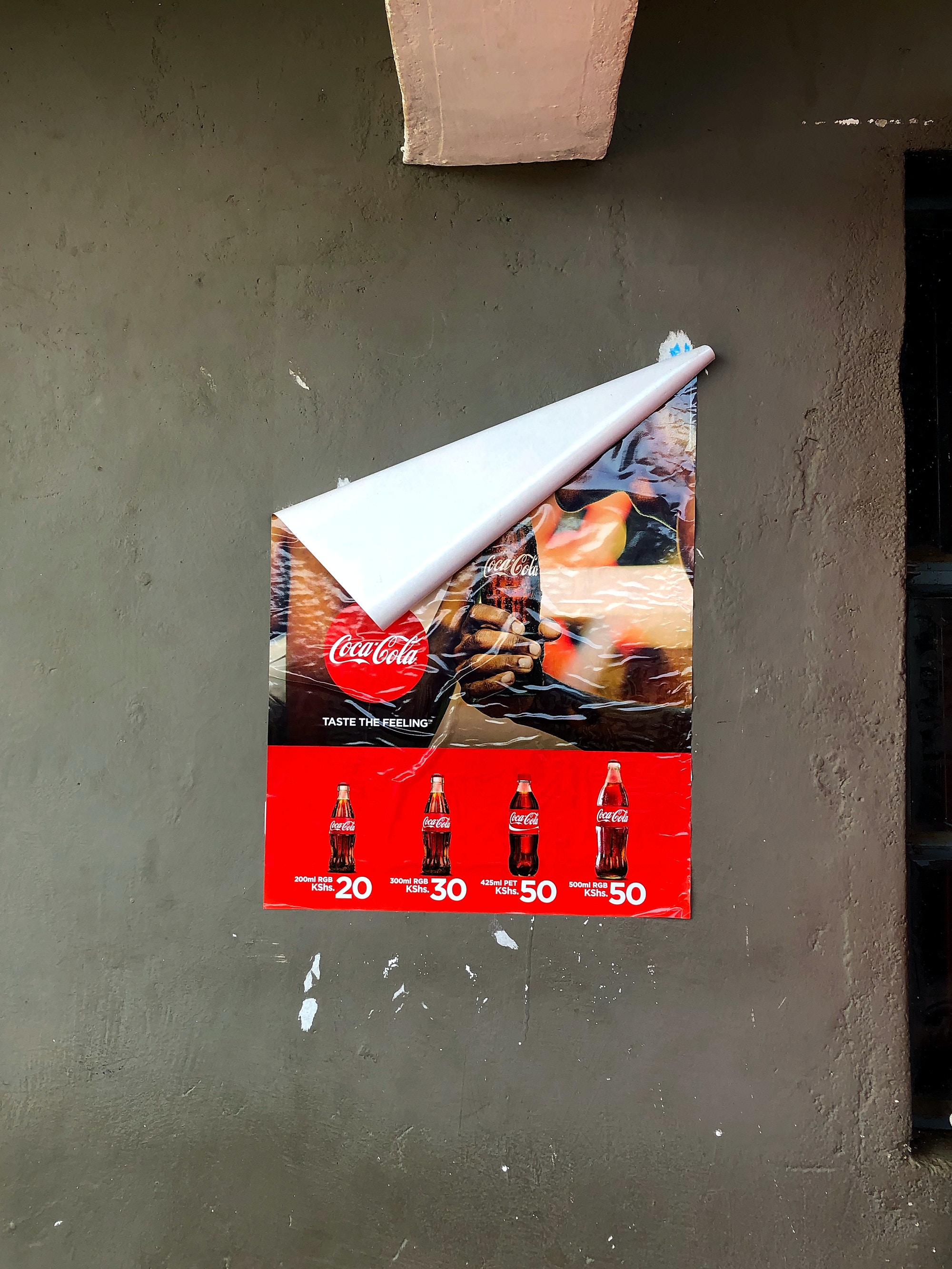
Photo: Sharon Lerner/The Intercept
Same Company, Same Plastic
In February, at a sustainability conference in Brussels, Coca-Cola executive Bruno Van Gompel made an encouraging presentation about plastic. Van Gompel, who works on the company’s supply chain, pledged that Coke would collect all of its packaging in Western Europe. But Coca-Cola has yet to commit to collecting all its packaging in African countries or any other part of the developing world. Coke did not respond to a question about why it has not made the same promise in other parts of the world, but noted that its 2018 pledge to collect and recycle the equivalent of every bottle or can the company sells globally by 2030 and make all of its packaging recyclable by 2025 applies to all countries.
Waste collection is not the only plastics-related issue that the multinational beverage company handles differently in different parts of the globe. Although Coke has a long history of opposing bottle bills, Van Gompel said that it will now support “well-designed deposit return schemes where a proven alternative does not exist.” But Coke has opposed a national bottle return system in Kenya and anywhere else in Africa. In her email, Osborne, the Coke spokesperson, confirmed that the company does not believe a container deposit system is appropriate for Kenya and said that it believes that PETCO is the right model for the country.
“Not all countries have the right pre-conditions for a successful” container deposit scheme, Osborne wrote. “We believe that under the wrong conditions, a deposit scheme can not only negatively affect the retail environment and frustrate consumers, but also potentially undermine existing recycling value chains by removing high value items like PET bottles and aluminum cans.” She also noted that “we currently participate in fair, industry-led deposit schemes in nearly 40 markets around the world.”
In truth, Coke has given only grudging support to the laws that require beverage companies to tack a charge onto the price of their drink to be refunded after it is returned. While Osborne noted the company’s support for bottle bills in “several U.S. states,” the company has a long history of opposing them throughout the country. Coke endorsed a Scottish bottle deposit plan in 2017, though only after Greenpeace released a leaked document showing that the company had fought against it for years.
In Australia, Coca-Cola eventually backed a container deposit law in the Northern Territory, but first sued to stop it. The national beverage industry trade group, to which Coke belongs, also lobbied hard against the plans. In one sense, Coke has lost the war against container deposit schemes, which have recently been set up in New South Wales, Australian Capital Territory, and Western Australia. While the implementation of Western Australia’s container deposit plan has been delayed because of the coronavirus, Coca-Cola now has a hand in running all of those programs.
Beverage companies may be averse to implementing these systems globally because of the cost, according to waste experts. “There are so many bottles lying around that if they instituted a real bottle refund system, it would be a huge unfunded liability,” said Usman Valiante, a senior policy analyst at the Circular Economy Lab in Canada, who dismissed Van Gompel’s pledge to a change of tune on bottle bills as “PR bluster.” “If there’s a 5-cent return, multiply that by billions and billions of bottles, and it instantly becomes billions of dollars. They say they want to meet these targets, but if they were really to make a meaningful effort, they would have to set up a reverse supply chain, which would mean employing people and building facilities, and they’re not up for any of that.”
Valiante predicted that beverage companies won’t quit plastic unless they’re forced to. “It’s extremely cheap to produce and use,” he said. For Coca-Cola, which has systematically dismantled the network of local companies that used to refill and distribute glass bottles as it has phased in single-use plastic, he said, the shift has had an added benefit. “Typically these bottlers were not only bottling Coke, but also local soda brands,” Valiante said. “When they went out of business, the local brands they were making were also eliminated. They killed their competition.”
Osborne insisted that Coke has not dismantled its African network of bottlers. On the contrary, she wrote, “many of The Coca-Cola Company’s (TCCC) bottling partners have been consolidated into Africa’s largest bottler, Cola-Cola Beverages Africa (CCBA), the eight largest Coca-Cola bottling partner worldwide.”
Although in his presentation in Brussels, Van Gompel promised that Coke would soon begin “exploring” refillable options, the company already knows well about these options, having pioneered them. In many rural parts of the developing world, the old signature fluted glass Coke bottles are still in use. In her email, Coca-Cola’s Osborne said that refillable bottles already make up half or more of sales in over 25 countries, though she included plastic bottles, such as those the company recently introduced in South Africa, in that figure.
Yet without intervention, Valiente warned, the company may succeed in getting rid of refillable, glass bottles. “If governments don’t bring in some mandates soon to use refillable containers, they will all go the way of the dodo bird pretty quickly,” he said.
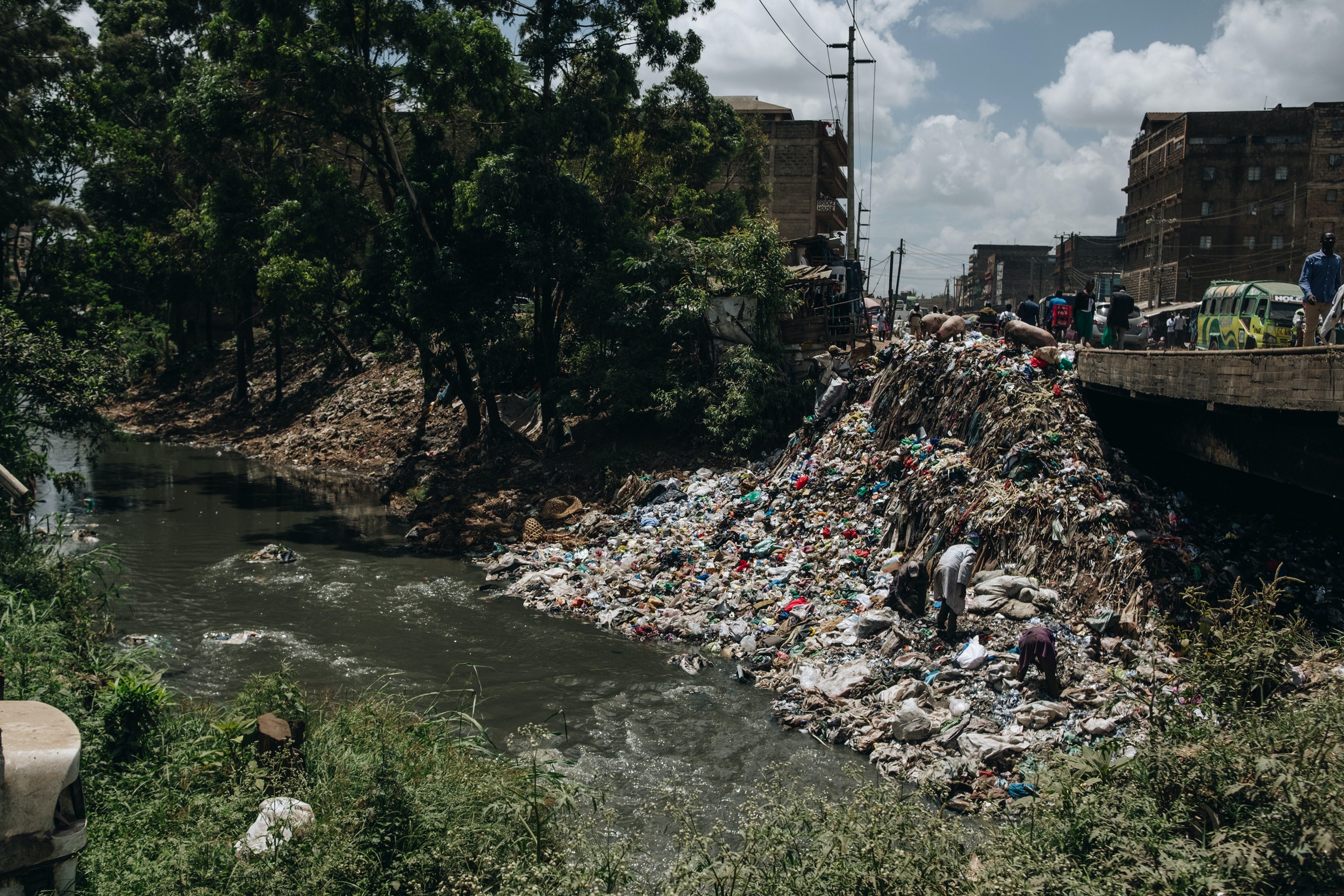
U.S. to the Rescue
So great is the public outrage over the global plastics problem that even the Trump administration, notorious for prioritizing business over the environment, recently began to try to address it. In November, on his last day as secretary of energy, Rick Perry announced a U.S. initiative to deal with plastic waste. Perry was stepping down after his efforts in Ukraine to cement a deal over natural gas — the primary fuel used to make plastic — ensnared him in the impeachment inquiry into Donald Trump. His parting program, the “Plastics Innovation Challenge,” would provide Department of Energy grants to American companies that have innovative ideas for addressing the plastics crisis. But if Americans could solve the problem, Perry insisted, they shouldn’t be blamed for it.
“I think there are like eight rivers in the world where close to 90 percent of the waste is going into the oceans,” Perry said on a press call. “None are American rivers.” He was referring to a 2017 study that has become a favorite of the plastics industry. Published in Environmental Science and Technology, the study did indeed show that just 10 rivers — eight in Asia and two in Africa — transport between 88 and 95 percent of the global plastics load into the sea.
But what Perry failed to note is that much of the plastic that has accumulated in these rivers originated in the U.S. and Europe — as did the products that were encased in it. Some 172 metric tons of plastics and its chemical components worth $285 billion were imported into 33 African countries between 1990 and 2017, according to a study published last year in Environmental Sciences Europe. And brand audits have repeatedly found Coke and Pepsi, quintessential American brands, among the top polluters in the world.
Even Christian Schmidt, the author of the study Perry cited, doesn’t think his research exonerates the producers of the plastic. “The big companies are not off the hook,” said Schmidt, who is based in Germany. While his research did indeed find massive plastic pollution in 10 rivers in Asia and Africa, including the Mekong, Indus, Yangtze, Yellow, Nile, and Niger, “they can’t say it’s just a local problem over there,” said Schmidt, who added that he felt “there should be increased producer responsibility” in Africa, as there is increasingly in Europe.
Regardless of the plastic’s origins, the Department of Energy, which did not respond to requests for comment, clearly sees the fact that it has wound up in rivers, oceans, and landfills as yet another business opportunity for American companies. As one department official put it, “While this is a problem largely not of America’s creation, we believe American leadership can play a big role in the solution.” For his part, Perry described the grant program as an opportunity “to work with other countries on some challenges they have.”
In February, the department announced that it would be partnering with the American Chemistry Council on the program. The trade group represents Dow, BASF, Chevron Phillips Chemical Company LLC, Exxon Mobil Chemical Company, LyondellBasell, and many of the other big multinational corporations that helped create the plastics problem the program aims to solve. Among the purposes for which the government grants can be used is the production of new plastic. While the funding announcement specified that the Energy Department would be looking for proposals to create new “recyclable” plastic, much of the plastic pollution in the ocean that the department is trying to address is — in theory, if not in practice — also recyclable.
For close watchers of the global plastics crisis, there is a bitter irony to the positioning of both poor countries as the cause of the plastics crisis and the U.S. as their savior. “We send them this garbage and then we’re going to turn around and say, ‘Look at these people, they can’t even manage their plastic,’” said Azoulay of the Center for International Environmental Law. “And now these same people are coming in and saying, ‘Oh, you have a problem? Let us give you a technological solution that we own, that we patent, and that you’re going to have to borrow money to put in place.’”
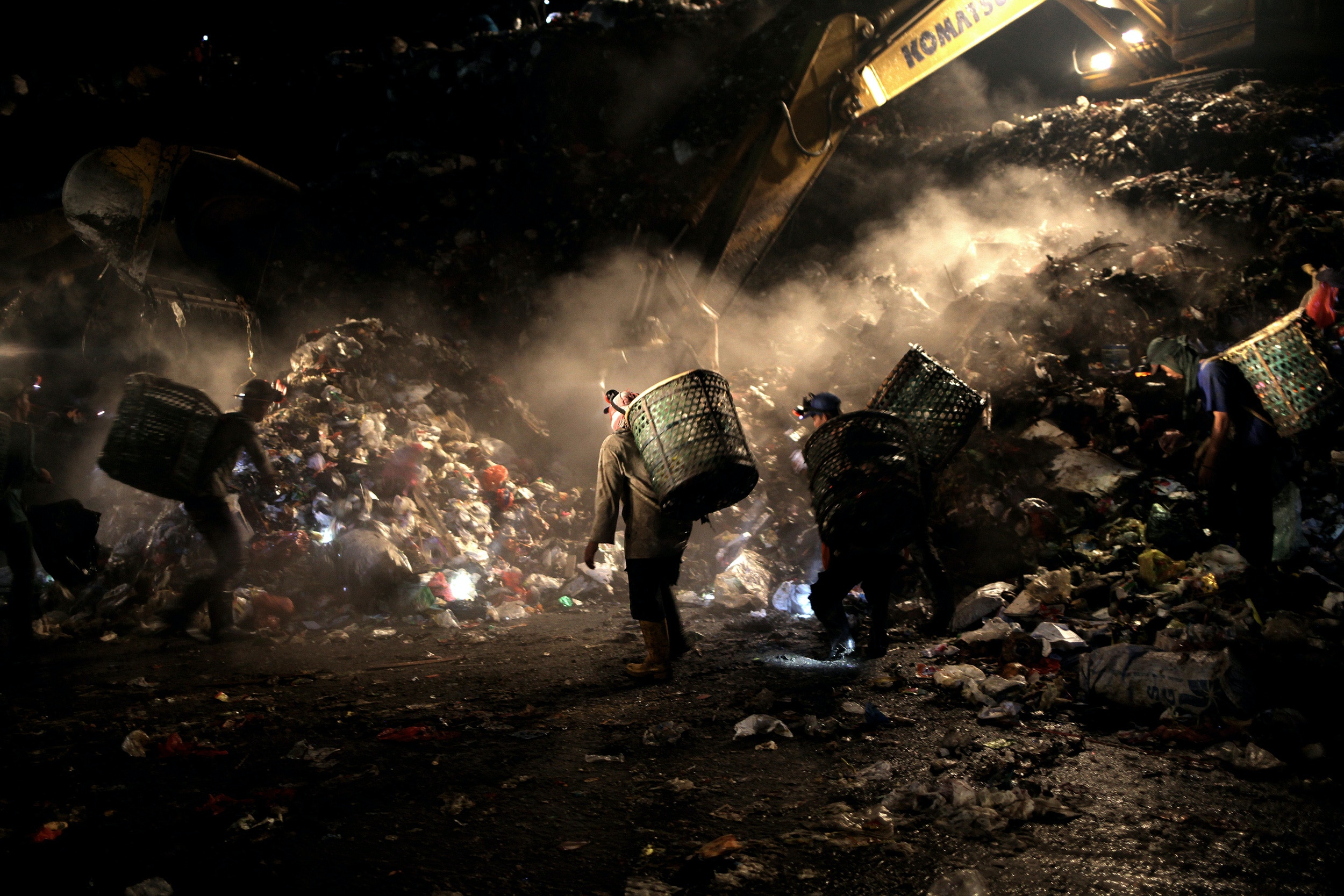
A Burning Problem
While the U.S. and the American Chemistry Council have focused on recycling as the solution, the repurposing and recycling of plastics can be particularly dangerous in the developing world. In Cameroon, plastic trash is melted into a sludge, which is then mixed with sand and used to pave roads, according to Gilbert Kuepouo, coordinator of the Cameroonian environmental group Research and Education Center for Development. While the Cameroonian Ministry of the Environment promotes the practice as environmentally friendly, the plastic is melted in “open air” and releases both greenhouse gases and toxic chemicals, according to Kuepouo.
Yuyun Ismawati, a senior adviser at Nexus3 Foundation, has similar concerns about the recycling of plastics in Indonesia. Ismawati visited a few plastics recycling plants near the Bantar Gebang landfill in Jakarta and worries about what she described as “poor conditions” there. “Some of the people work with minimal protections considering how many chemicals are involved. And some of the women told me they have problems with headaches and irregular menstruation,” said Ismawati. “There were so many fumes in that factory. My eyes and throat hurt when I was there.”
Meanwhile, the outright burning of plastic, while even more dangerous than melting it for recycling, is the primary disposal method in many countries. While some 41 percent of waste is openly burned around the world, in certain African cities as much of 75 percent of garbage is disposed of this way. The international climate group G20 calls the practice, which exacerbates climate change and creates toxic and cancer-causing air pollution and ash, a “global health disaster.”
Tests done in Agbogbloshie, a neighborhood in the Ghanaian capital of Accra, give us a window into how easily the chemicals produced by burning plastic can make their way into food. Agbogbloshie is the final destination for much of the estimated 40 million tons of electronic waste the world produces every year. The scrapyard, which sits next to a lagoon near the city center, has been celebrated as the perfect market-driven solution to waste. And it’s true that the traders there find ways to repurpose obsolete computers, TVs, and other electronics that are considered trash in the U.S. But cables, wires, and other plastic bits of these products that are deemed unusable are burned in Agbogbloshie. And eggs laid by chickens that forage nearby contained the second-highest level of brominated dioxins ever measured, according to the International Pollutants Elimination Network, which performed the tests last year. The chemicals can harm developing fetuses, disrupt the functioning the immune and endocrine systems, and cause cancer. The network also found extremely high levels of the flame retardants HBCD and PBDEs in the eggs at Agbogbloshie and measured these same chemicals in eggs sampled near medical waste incinerators in Accra and Yaoundé, the capital of Cameroon.
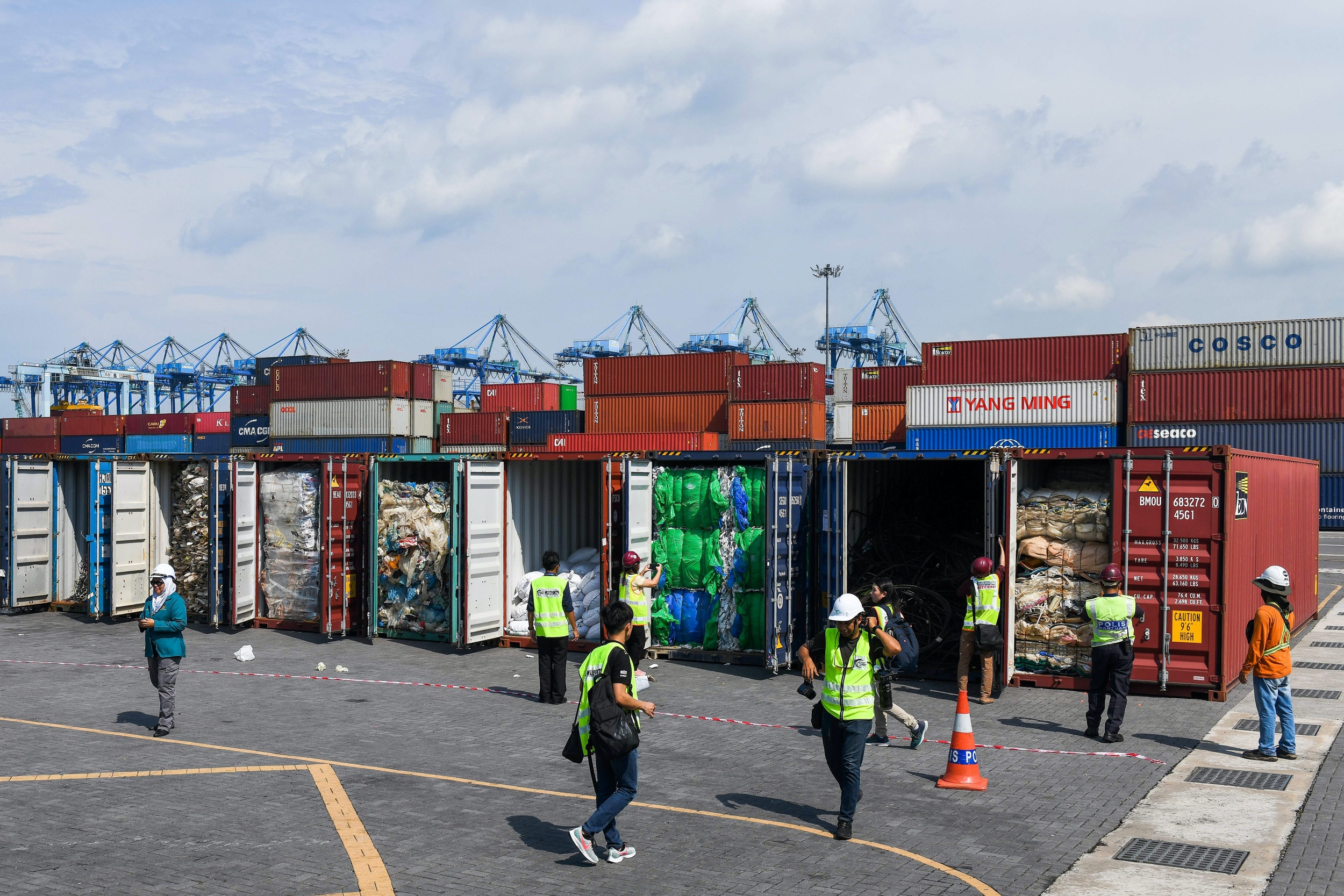
The Plastic Waste “Trade”
While developing countries are struggling to deal with their mounting garbage, the U.S. is adding to their burden by exporting massive amounts of plastic trash that it can’t process to nations that have even less ability to properly dispose of it. In 2019, American exporters shipped almost 1.5 billion pounds of plastic waste to 95 countries, including Malaysia, which received more than 133 million pounds; Thailand, which got sent almost 60 million pounds; and Mexico, which got 81 million pounds, according to the most recent data. Ghana, Uganda, Tanzania, South Africa, Ethiopia, Senegal, and Kenya were among the African countries that also received American plastic garbage, most of which was the hardest to recycle and the least-valued plastics. The United States categorizes all of this exported plastic as “recycled,” even though extensive reporting and on-site investigations have shown that much of it is either dumped or burned.
The large-scale international shipment of plastic trash from rich to poor countries is often described as the “global waste trade,” but it doesn’t work like a typical trade. Because the value of scrap plastic is so low, these days many businesses that receive it are being paid rather than paying to get the stuff. The small opportunity for income it provides has made it difficult to stop the imports. India passed a ban on the import of scrap plastic in 2018, for instance. But implementation of the ban has been delayed twice. And in the meantime, the U.S. has sent the country at least 188 million pounds of its plastic garbage.
Jamaica also receives American plastic waste — more than 100,000 pounds last year. And that’s just what’s in the official record. An unknown amount of U.S. garbage enters the country in other ways, including under the guise of humanitarian aid, according to Sherika Whitelocke-Ballingsingh, who has been a public health inspector in Jamaica and now works for the Caribbean Poison Information Network. “Charitable groups will send shipping containers marked as aid, but when you open up the containers, sometimes only maybe 10 percent of what’s inside is usable. The rest of it is garbage,” said Whitelocke-Ballingsingh. “I’ve had to arrange to get these things to the dump myself.”
Several countries have been trying to stem the tide of plastic garbage that has swelled since China stopped receiving it in 2018. In September, Cambodia returned 83 shipping containers full of waste to the U.S. and Canada with a message from Prime Minister Hun Sen: “Cambodia is not a dustbin.” In January, Malaysia sent more than 8 million pounds of plastic trash back to the U.S. and 12 other rich nations. And in Indonesia, a customs official announced last year that hundreds of shipping containers, many of which had been incorrectly labeled to mask the fact that they contained plastic waste, were being sent back to their “countries of origin,” including the U.S.
But returning garbage to sender turns out to be incredibly difficult. A closer look shows that, instead of being sent back to the U.S., many of the shipping containers from Indonesia were instead shipped to other poor countries, including India, Thailand, and Vietnam, according to a report by the Nexus3 Foundation, which has been tracking the situation. And more than 1,000 of the seized shipping containers remain in the port of Jakarta, according to Nexus3’s Ismawati, who is particularly concerned that the remaining waste will also be hard to repatriate and may wind up in poor countries. “Somebody somewhere will always be willing to accept some money for crap,” she said.
To Ismawati, all the waste moving into Indonesia and throughout the developing world belies the notion that recycling can solve the plastics problem. “If recycling is so great, such an environmental good, why don’t developed countries do it there?” she asked. “If you’re so advanced that you can send rockets to the moon, why can’t you build recycling plants in your own countries?”
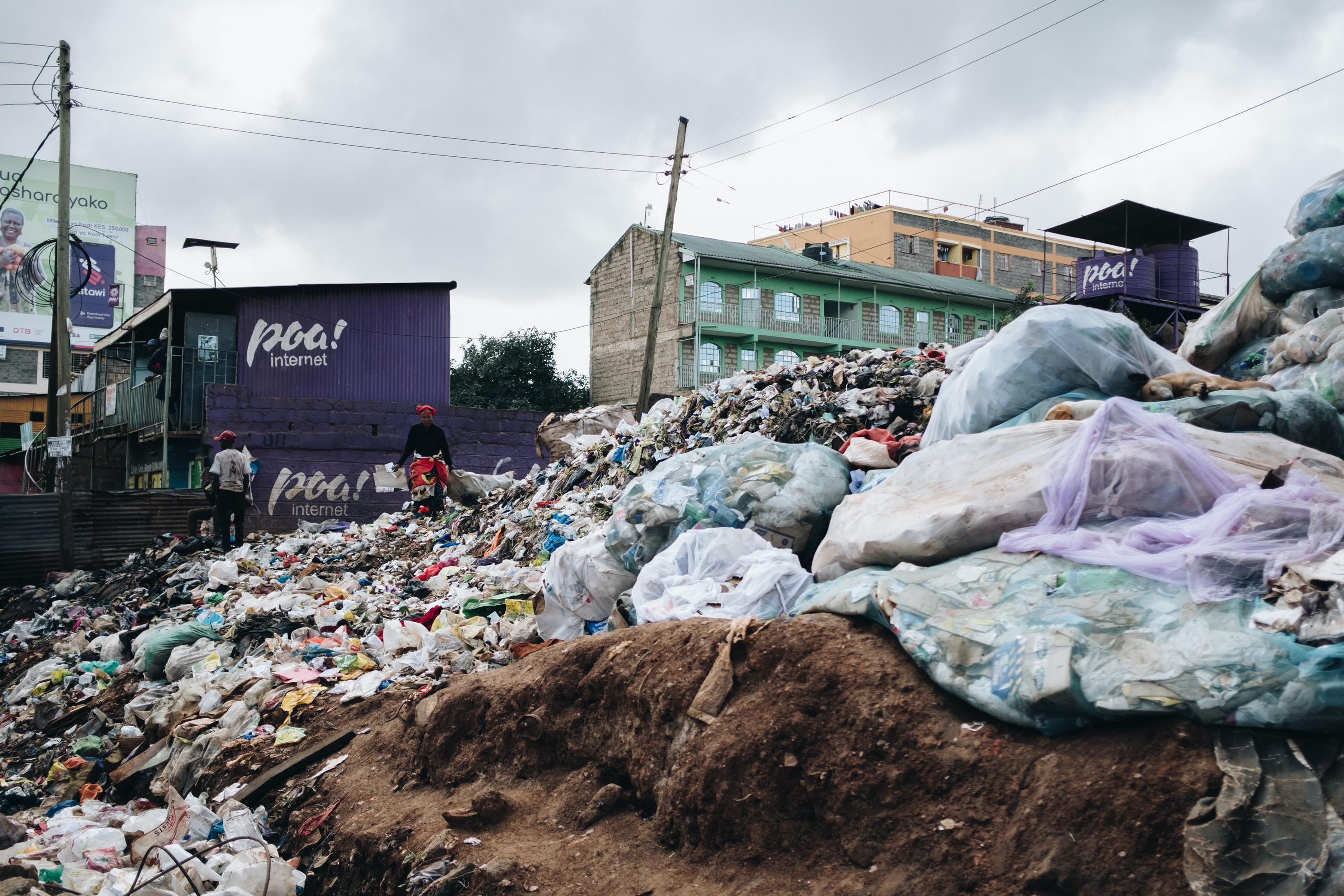
Photo: Khadija Farah for The Intercept
The Exploding Balloon
As much as plastics are already causing a worldwide garbage fight, the real battle has yet to come, according to Jim Puckett, who tracks the international movement of waste as executive director of the Basel Action Network. “It’s a balloon that’s going to explode,” he said of the international tensions over plastic trash. “All the brokers are trying to find the next country that’s going to take this stuff. We’re talking about massive amounts of waste, just mountains and mountains of material. And you can’t hold it on tarmacs forever.” While the plastic mounts, so too does the pressure to stop its import. “Once people start to see and smell it and realize it’s being burned in their backyards, they say no way,” Puckett said.
Last May, that pressure increased when representatives of 187 countries gathered in Geneva for a meeting of the Basel Convention. The U.S. is one of a tiny handful of countries that have not joined or signed that international treaty, which governs hazardous waste, but an American delegation attended the meeting anyway along with representatives of the American Chemistry Council. A major amendment was on the agenda that could severely limit the ability to export plastic waste to member countries, which make up most of the world. If it passed, it could put an end to the shipping containers full of mixed plastic the U.S. has been sending abroad for decades.
The conference was extended by several days to allow the countries to negotiate the contentious amendment. Even with the extra time, the debates went on well into the night, with the U.S. and the American Chemistry Council arguing against it through the Argentinian delegation and almost all of the remaining members supporting it. Treaty negotiations are usually somber affairs where policy pronouncements are met with respectful silence. But when the president of the conference, Abraham Zivayi Matiza, announced the unanimous passage of the plastic amendment after several days of near-nonstop negotiations, “the room was filled with thunderous applause,” said Joe DiGangi, a senior science adviser to the International Pollutants Elimination Network who attended the meeting.
Not everyone was happy. After the vote, DiGangi wound up riding the elevator with a lawyer who was representing the plastics industry at the meeting. “He looked at me, shook his head, and said, ‘You guys just restructured the entire plastics trade.’”
While it’s still unclear what consequences U.S. companies will suffer if they choose to continue sending their plastic waste abroad, the quick passage of the Basel amendment signals that we’ve reached a new stage in the international war over plastic, in which most countries see the need for urgent action. It usually takes many years, sometimes decades, to hammer out international environmental treaties, but the Basel amendment on plastic, which will take effect in January 2021, passed less than a year after it was first proposed. “I’ve never seen any international agreement move as fast as that amendment,” said Puckett.
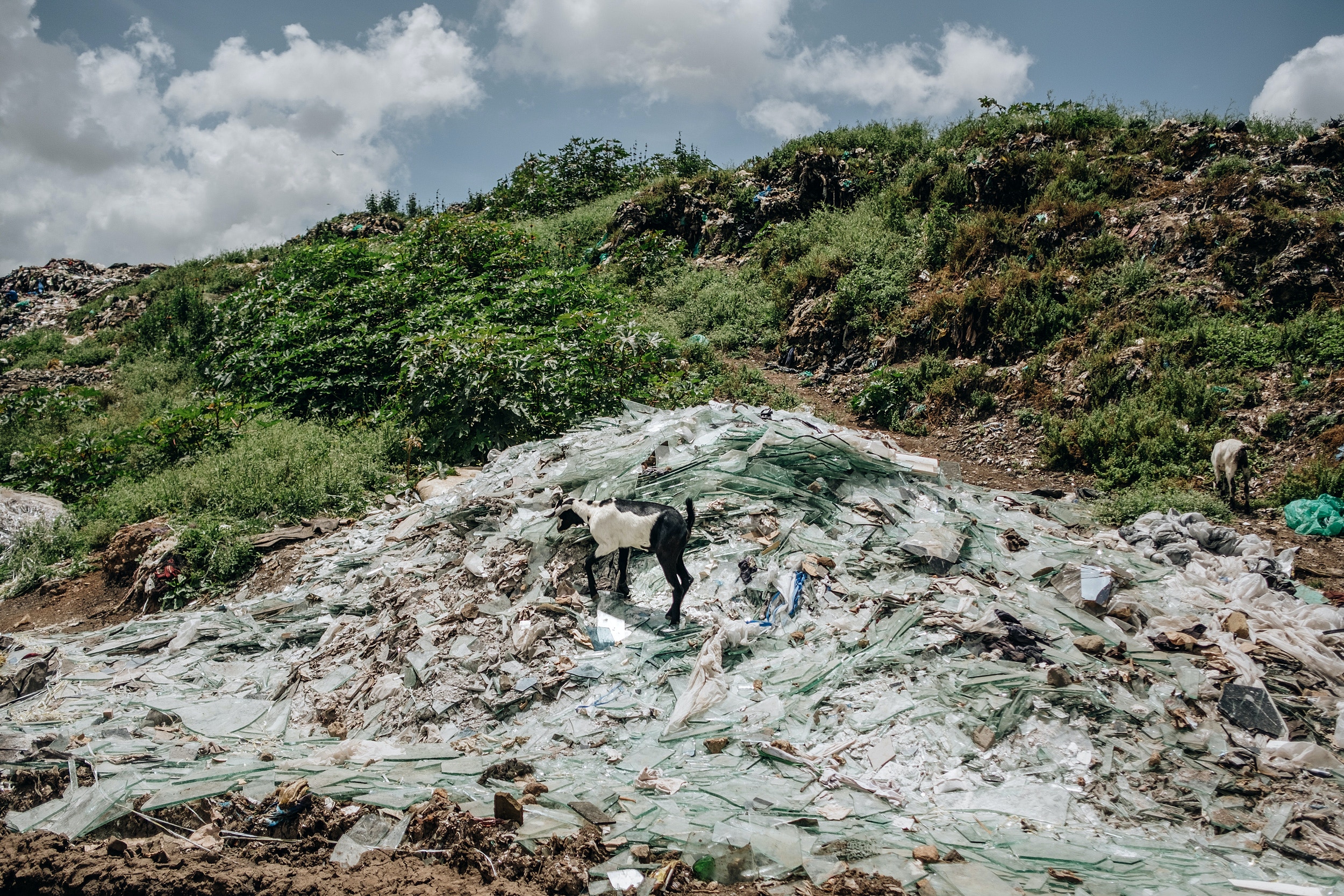
Photo: Khadija Farah for The Intercept
The urgency that fueled the quick action on the treaty is now dovetailing with unprecedented economic disruption caused by the coronavirus pandemic. And some predict the combination will put an end to the steep increases of plastics production. While unabated growth has gone on for decades, before the pandemic, the industry was planning to significantly ramp up its usual expansion. In February, the American Chemistry Council announced more than $200 billion in investments in new infrastructure for the production of plastics and petrochemicals. In Africa, the amount of plastics and polymers that will become plastic products imported from the U.S. and other countries was recently predicted to double by 2030.
But that trajectory has changed, according to Carroll Muffett, president and CEO of the Center for International Environmental Law. “Industry had already recognized that its assumptions about how plastic would grow were wildly optimistic,” said Muffett, who pointed to coronavirus-related delays in the construction of new plastics and chemical plants, an increase in bankruptcies among fracking companies, and unprecedented drops in fossil fuel production as evidence that the industry is now headed for further trouble.
Even the industry’s promotion of plastics as a tool to fight the pandemic won’t prevent its inevitable contraction, according to Muffett. “Will they exploit this to pitch more expansion under the guise of consumer hygiene? Certainly. But will that be enough to offset the declining acceptance of plastic combined with the instability of the entire petroleum sector? I don’t think so.”
It’s too soon to know whether Muffett is right. And, in any case, if it comes to pass, a contraction of the plastics industry will play out over years and decades. In the meantime, Africa is bracing for the coronavirus, which, like the plastics crisis, will affect that continent differently than it has the rest of the world. In Kenya, which had just under 300 confirmed coronavirus infections as of press time, many do not have the reserves to survive while on lockdown. Panic about food has already led to a stampede in one Nairobi slum. Last week, as the number of cases ticked upward, the country suspended foreign travel and schools. Still, at the Dandora dump, men, women, and children could be seen fanned out over the vast piles of garbage last week, sorting through the trash with their bare hands. Although the government made face masks mandatory, many of the waste-pickers weren’t wearing them. Whether because they couldn’t find them or couldn’t afford to buy them, they were risking both arrest and contagion so they could earn enough to survive.
19 April 2020
The Intercept

